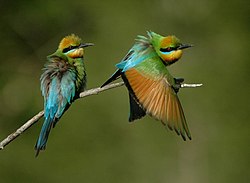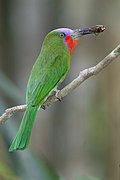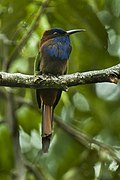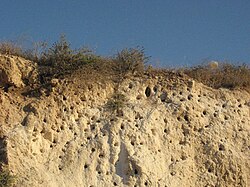Bee-eater
The bee-eaters are a group of land birds in the family Meropidae.
| Bee-eater | |
|---|---|

| |
| Six common African bee-eaters | |
| Scientific classification | |
| Kingdom: | Animalia |
| Phylum: | Chordata |
| Order: | Coraciiformes |
| Family: | Meropidae Rafinesque, 1815 |
| Genera | |

| |
Approximate area in which
bee-eater species regularly breed | |
They live in the Old World and Australasia: Africa, Asia, Europe, Australia, and New Guinea. They have richly coloured plumage and slender bodies. They have long downturned bills and pointed wings, which give them a swallow-like appearance. There are 26 different species of bee-eaters.
As the name suggests, bee-eaters eat flying insects, especially bees and wasps. They catch them in the air by darting from a perch.[1] The birds only catch prey which is flying: they ignore flying insects once they land.
Mostly, they eat honeybees. Hymenoptera (ants, bees and wasps) make up from 20% to 96% of all insects eaten.[2] Before eating its meal, a bee-eater removes the sting by repeatedly hitting and rubbing the insect on a hard surface. The bird squeezes out most of the venom.[1]
Bee-eaters live together. They form colonies by nesting in burrows tunnelled into the side of sandy banks, such as those that have collapsed on the edges of rivers. Many of these holes occur together.
Most of the species in the family are monogamous, and both parents care for the young, sometimes with the assistance of other birds in the colony, a behaviour rather unusual for birds.[1]
Bee-eater Media
Rainbow bee-eaters, a Merops species
Merops species such as the white-fronted bee-eater usually have a black bar through the eye.
The blue-bearded bee-eater is associated with forests, where it forages in edge habitats
A male blue-throated bee-eater presents his mate with a captured insect
Asian green bee-eaters dust bathing to keep down parasites
References
- ↑ 1.0 1.1 1.2 Forshaw J. & Kemp A. (1991). Encyclopaedia of animals: Birds. London: Merehurst Press. pp. 144–145. ISBN 1-85391-186-0.
- ↑ Fry, Fry and Harris 1992. Kingfishers, bee-eaters, and rollers. ISBN 978-0-7136-8028-7










